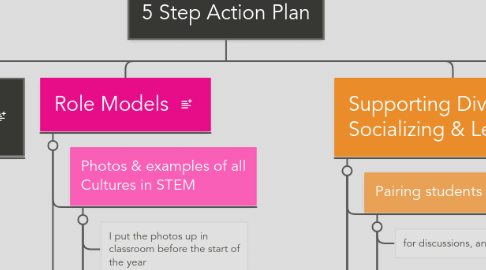
1. Resources
1.1. Article
1.1.1. Enrica Ruggs
1.1.2. Michelle Hebl
1.1.3. 2012 Rice University
1.2. Article
1.2.1. Bridging Cultures with Classroom Strategies
2. Monitoring Interventions
2.1. Short Term Goals
2.1.1. Daily & Weekly - take action in some or all categories on this chart
2.2. Long Term Goals
2.2.1. Social Integration with other students within & outside class
2.2.2. Language Acquistition
2.2.3. Student Confidence, Competence, and Interest in Science
2.2.4. Breakdown barriers for minorities & girls/women entering STEM fields
2.3. Tracking Students
2.3.1. Self Efficacy & Self Confidence
2.3.2. Pursuit of Science
2.3.3. Interest in Science
2.3.4. Increase in Knowledge
2.3.5. Academic Performance
3. Reframing Teaching/Learning to include minority cultural norms
3.1. Collectivist - both Latino & Filipino Cultures
3.1.1. See Helpfulness & Interdependence as valuable
3.1.1.1. Pair children at different levels of language
3.1.1.2. Jigsaw group projects
3.1.2. Ask for family stories about subject
3.1.2.1. Scaffold Science Info
3.1.2.1.1. Write story details on left side of board and science on right
3.2. Include cultural examples in teaching
3.2.1. Use 'the everyday' to 'find science'. For example, cooking (use examples of traditional latino and filipino dishes)
3.3. WHY??? This will not only benefit the Latino & Filipino cultures, but studies in higher education are showing that cross-cultural interaction benefits ALL students
3.4. Establish Rules: Filipino culture is one of restraint and rules create security
3.4.1. I will post rules in room, and make sure the students understand them
3.4.2. I will be consistent with rules
4. Role Models
4.1. Photos & examples of all Cultures in STEM
4.1.1. I put the photos up in classroom before the start of the year
4.1.2. Throughout year add to them according to topic studying
4.1.3. reports/discussions/sharing about role models throughout year
4.1.3.1. I assign - some study outside class, some inside, some groupwork within the class
4.2. Guest Speakers
4.2.1. Family members
4.2.2. Community members
4.2.3. In person if possible, but using skype or other technology
4.2.4. Bring in someone I know within 1-2 months, gather information from students & their families to plan speakers in school year
5. Supporting Diversity in Socializing & Learning
5.1. Pairing students inside classroom
5.1.1. for discussions, and group work
5.1.2. Students with same native language: one who is more advanced in learning English
5.1.3. Why? Fits with culture: Interdependence is valued in Latino & Filipino cultures
5.2. Jigsaw Groupwork inside classroom & some projects outside
5.2.1. Give each child crucial piece of the groupwork
5.2.1.1. Visual clues to ELL
5.2.2. Why? Interdependence, practice socializing & fostering culture of diversity
5.3. Projects with students across the globe
5.3.1. I will need to research this, and use my connections
5.3.2. Videothread projects
5.3.2.1. Include student's native languages within project
5.3.3. Why? To validate minority cultures, To give global awareness to all students
5.4. Afterschool Programs
5.4.1. Parents, teachers and students to be involved and encourage participation
5.4.2. I and other teachers can make sure kids are paired as buddies to sign up for activities
5.4.3. Why? To help the students connect with others, and to be involved in different groups of people/activities
5.4.4. Supports value placed on leisure time and expression
6. Language Learning
6.1. Choral repeating of words
6.1.1. Each class
6.2. Homework discussion
6.2.1. have them all discuss the homework questions or assignments before leaving
6.2.2. They write answers at home
6.3. Targeted Practice of words
6.3.1. I will not over-correct when the ELL are having fun, or expressing themselves during discussions.
6.3.2. I will set some practice of vocab times, and pair or group students accordingly
6.3.2.1. writing
6.3.2.2. speaking
6.3.2.3. I will go from pair to pair, group to group to support and encourage
6.4. Assess & Track stage of English Language Aquisition
6.4.1. Adjust teaching assignments, interaction accordingly
6.4.2. Include Visuals in class and group projects
6.4.3. Is the child in ESL classes as well? If not could they be? Do they need extra tutoring - if so recommend.
6.4.3.1. Coordinate with ESL class teacher as necessary
7. Connect with Parents/Families
7.1. Parents/Guardians, Teachers, Students
7.2. Parent/Teacher Conferences
7.3. I will make sure I contact each family as early on as possible to give positive feedback about child, and open lines of communication
7.3.1. I will see if I need to get translator for meetings/conversations
7.4. I will need to be warm, accessible, non-judgmental, and open to concerns the parents may have about their children/school
7.5. Assess how much educational support & resources are available to child through parents
7.5.1. Support as much as possible
7.5.1.1. During 1st year develop list of resources in school and community
7.5.1.1.1. Translate into Spanish, and Filipino/Tagalog as I can enlist support from parents/teachers to do so
7.5.1.1.2. Ask parents/families what resources they have found helpful & add to list
7.5.1.1.3. KEEP LIST UPDATED as necessary
7.5.1.2. Find out what parents/family interests might be and see how learning could be enhanced: could fun experiments be done with parents? Would video clips/ programs in native language or English be enjoyed? Would family enjoy a butterfly garden?
